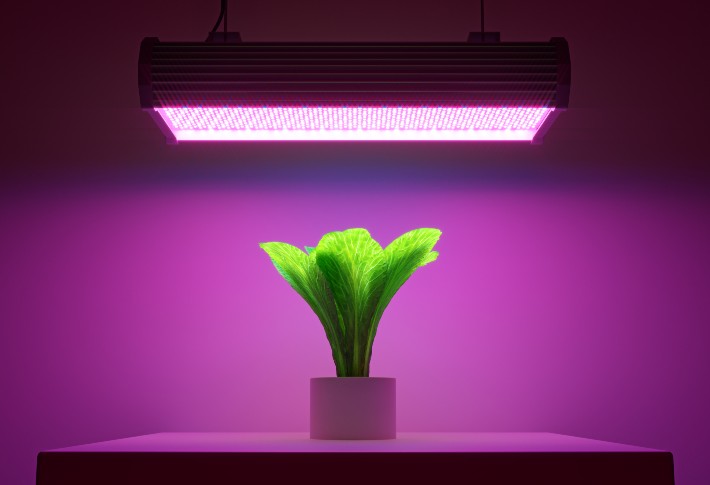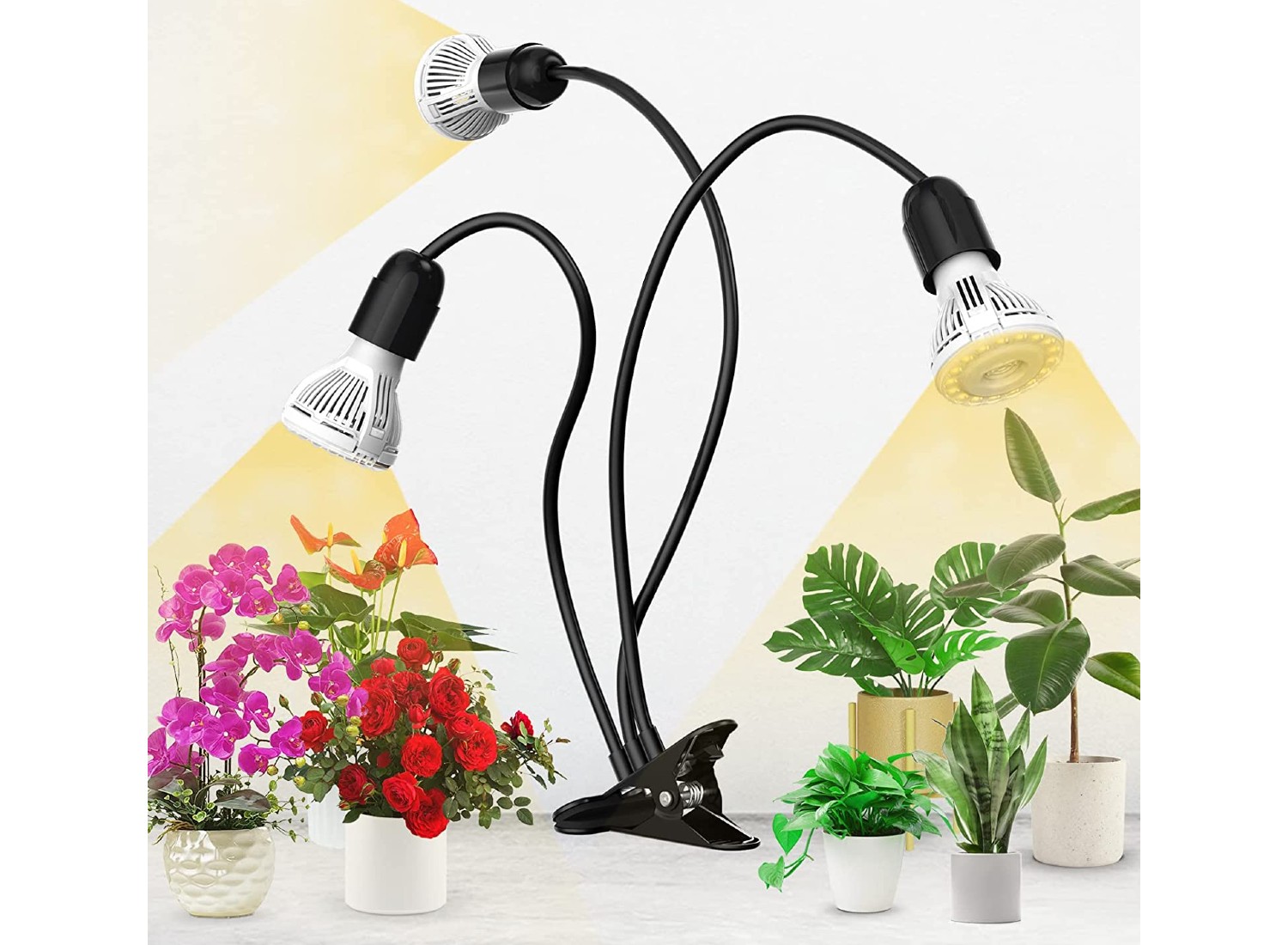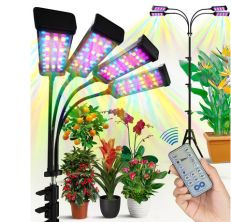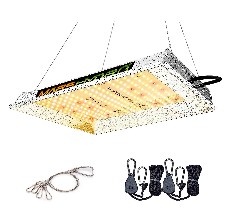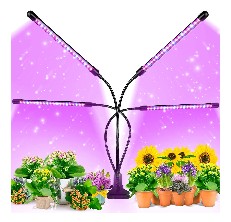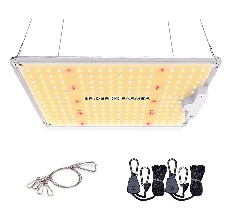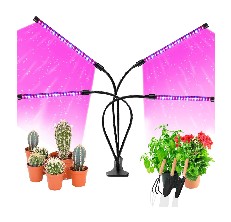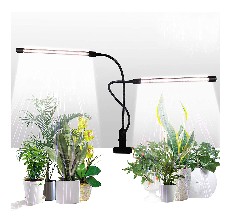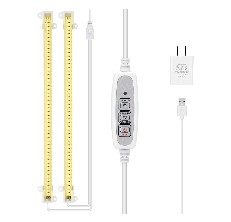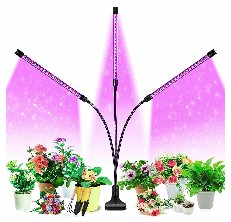- Flowers & PlantsVegetablesOur content is meticulously curated through independent research, testing, reviews, and AI-driven recommendations, all designed to present you with the finest product choices. When you make a purchase through our links, it could result in us earning a commission.
The Best Grow Lights of 2024
Last updated: Apr 30, 2024
Whether you're an experienced indoor gardener with a green thumb or just starting your journey with indoor plants, selecting the right grow light is crucial for your plant's health and growth. In this article, we're diving deep into the world of grow lights. We'll explore their fantastic benefits, such as promoting healthy growth, extending growing seasons, and providing supplemental light during low-light periods. Additionally, we'll discuss the different types of grow lights available, including fluorescent, LED, and HID lights, and their specific advantages and applications. Plus, we'll share some insider tips on how to pick the perfect option for your indoor gardening setup. And let's not forget about the star of the show: SANSI grow lights. Renowned for their exceptional quality and performance, they're a great choice for indoor gardeners. Join us as we embark on a journey to uncover the secrets to cultivating thriving indoor plants.
Our Top Picks For Grow Lights
- Best Overall: Sansi Grow Light Shop Now ➔
- Most Versatile: Everlasting Comfort Grow Light Shop Now ➔
- Most Affordable: MARS HYDRO Grow Light Shop Now ➔
- Honorable Mention: EZORKAS Grow Light Shop Now ➔
- Contender: SPIDER FARMER Grow Light Shop Now ➔
- Also Consider: JUEYINGBAILI Grow Light Shop Now ➔
- Sleekest Design: GHodec Grow Light Shop Now ➔
- Easy to Use: Mosthink Grow Light Shop Now ➔
- Most Unique: HOOMEDA Grow Light Shop Now ➔
View all ContentsThe Best Grow Lights
Best Overall
The Sansi Grow Light will have you plants flourishing throughout your home in no time! You get three adjustable LED lamps to shine on your dying plants to bring them back to life. Save a ton on your electric bill with these lights, as they only use 30 watts of power over a whole day. You can use the adjustable gooseneck to focus one light on one plant or pull it back to cover multiple plants.
The clip at the base of the light can be attached to the side of a counter, chair, or shelf so you can place it virtually anywhere. The patented ceramic technology connects directly to the LED chip, which allows the heat and light to work more efficiently. These lights will last practically a lifetime, as they have a lifespan of 25,000 hours. These neat features elevate this grow light from Sansi to the best overall on this list.
Pros
- Patented ceramic technology
- Heats and provides light to plants
- Saves money over time
Cons
- Light does not stay in position
Most Versatile
The Everlasting Comfort Grow Light offers a comprehensive solution to growing your plants, seedlings, herbs, and vegetables indoors. This grow lamp is equipped with four movable lamp heads and comes with 11 different brightness settings and seven color modes to perfectly suit your plants psychological needs. With 204 full spectrum LEDs, this grow light is sure to provide optimal lighting conditions year round.
In addition to the adjustable tripod stand that extends up to 63 inches, this plant light also comes with a wired and wireless remote control for even greater versatility. With both remotes, you can easily adjust the brightness levels and color settings as needed. What’s more is that each lamp can also be programmed to have different brightness levels and color settings, as well as run times of up to 18 hours with the six timer settings available. This grow light is an invaluable tool for those looking for an all-encompassing solution for their indoor growing needs.
Pros
- Super flexible light
- Eleven brightness settings
- Easy to set up
Cons
- Not adjustable enough for taller plants
Most Affordable
These LED grow lights help you make your plants grow faster as a natural growth from sunlight. These grow lights have full spectrum 3000K 5000K and IR 660nm 760nm red. It is suitable for all stages of growth. These are scientifically more energy-efficient, which is perfect for the 2’ x 2’ veg stage and also for the 1.5’ x 1.5’ bloom stage.
Pros
- Wide coverage and strong illumination
- Sunlike full spectrum LED
- Noise-free lights
Cons
- Sometimes it burns leaves
Honorable Mention
These LED lights are made with polyvinyl chloride material. It is suitable for indoor gardens and plants. It has auto-turn on and off 3 cycle timer modes which are its unique property. You can set the timer according to your convenience. It has 9 dimmable modes. These are easy to use as you can connect the adapter to the device, plug it into a switch, and adjust the distance and lighting as needed.
Pros
- Three switch modes
- Improves the taste of vegetables
- Improves the quality of flowers
Cons
- Growth of the seeds may vary
Contender
These corded electric stainless steel, aluminum grow lights use the latest technology in high-yielding LM301B diodes. It has high efficiency with 2.5 umol/J. It is designed as an upgraded SF series, which has a dimming knob and light switch. It consumes less power than the HPS or other SMG LEDs.
Pros
- Ideal for all growth stages
- It has excellent full-spectrum lights
- Multi-connection with unified dimming
Cons
- Results may not be consistent
Also Consider
This traditional multicolor LED light is designed with aluminum and polyvinyl chloride, which is the newest with four goose-necks. It solves the trouble of inflexibility of hanging the grow lights and also provides a wider coverage area.
Pros
- 360-degree adjustable goose-necks
- Provides a steady current
- Brightness ranges from 20-100%
Cons
- Light may need to be propped up
Sleekest Design
These grow lights are made with metal material, providing white LED light for the production of plants inside homes and indoor gardens. These are also effective when your plant needs extra sunlight during rain, snow, or night.
Pros
- Versatile clips are very handy
- Dimming feature is adjustable
- Convenient auto timer
Cons
- Instructions may not be clear
Easy to Use
These full spectrum grow lights emit wavelengths ranging from 380 nm-800 nm, which is almost equal to natural sunlight. These grow lights have four different brightness variations as 25%, 50%, 75%, and 100% so that you can adjust the brightness according to the plant requirements.
Pros
- It accelerates photosynthesis
- It has a compact design
- This light is certified
Cons
- May not work as well as grow lamps
Most Unique
This red/blue spectrum LED grow light is easy to use and has 10 dimming lights. Its blue spectrum helps the germination of plants, and the red spectrum promotes plant growth. It has auto turn-off specification after arriving at the time of your choice
Pros
- It is suitable for indoor plant growth
- This light has an adjustable goose-neck
- It has three timing modes
Cons
- It comes with a foreign plug
The Best Grow Lights: A Buyer's Guide
Quality build and material
Durability is one of the most important things about an LED light bulb for indoor plant production. If your lights are designed with the best quality material, i.e., polyvinyl chloride, metal, aluminum, etc., then the lamps last for 10 years or more, so you don’t need to worry about your setup in your living space. You should buy your energy-efficient LED grow lights from the best standard companies.
Brand reputation
The most difficult task is to choose the best brand to purchase your products. However, all the brands have their own specifications, considering that not all options are of equal quality.
When you find all the brand LED lights equal in price and appearance, then you should go for brand reputation. Check the customer reviews, long history, and company research make your decision easier
Quality semiconductor chip
The semiconductor chip serves the purpose of converting electricity to light and also plays an important role in determining the wavelength. For sufficient illumination, we advise you to look for a light that has a chip of at least 3 watts.
Key Considerations When Buying a Grow Light
Electricity consumption
Your LED light bulb operates 10-12 hours regularly, which leads to an increase in the electricity bill.
Read the brand description about the product carefully, as it may help you to choose the best option and save you from trouble in the future. Moreover, always check how many units is the total output.
Plant growing space
Always remember that your space at home is an important factor to note while purchasing the lamps as the size of the lamp depends on the space available in your production area.
Let’s suppose you are planting in a room, firstly measure the exact size of your room. Then, measure the lighting area size of the lamp that you are considering using for your plant production. The size of your room will also decide how many lamps are used in that specific area.
Furthermore, you should consider that according to the general guidelines, if you are planting high-light plants, you just need to use 32 watts of actual power per square foot, but planting low-light plants like lettuce need 11-18 watt per square foot.
Low heat output
This factor is one of the most important factors in choosing LED lights as it is comprised of two factors:
- Plant protection
- Durability
This factor is important because light having low heat output guarantees that you would not face any damage to your house plants, but it is necessary to keep a smaller distance between the lamp and the plant. In contrast, lamps that have high heat output may burn your plants more quickly.
Flexibility and ease of use
Sometimes, you may face some trouble in the adjustment of the lamp as it can not stay horizontal, so you have to prop them to keep them up from your plant. When you buy the best quality lamp, these are more efficient and also easy to use.
Moreover, an adjustable feature of wavelength and light intensity is also an essential part while choosing the best-LED lamps for your plants.
To learn more about all the basics of LED grow lights, watch this video from MIgardener:
Consider the Things You Want To Grow Before Buying a Top-Notch Grow Light
You must know which LED grow light is suitable for which plant as not every light is perfect for all plant types. Every light will do the job according to its specifications, but certain conditions are applied to certain house plants.
Blue lights are used for germination, while red is used for the growth of plants. On the other side, heavy crops need different light, and lighter crops need light to maximize the growth of plants.
So it is important to consider the type of plant you are growing while choosing energy-efficient LED lights.
Full-spectrum LED lights
Although plants can grow under any type of light, the best LED grow light provides the pants with a full spectrum and efficient photosynthesis.
Powerful full spectrum LED grow lights help you to grow your plants more efficiently as sometimes your plant needs blue or red spectrum and also infrared and ultraviolet at some instant. While COB and white light LEDs can grow plants, they aren’t necessarily the most efficient. White LEDs produce only 40% of usable light while wasting the rest in power consumption and heat.
Know Before Buying Whether the Light Is of the Full Spectrum or Not
If your package contains a list of both CRI and KELVIN ratings from the brand, it shows that the light is of the full spectrum as the rating shows the color spectrum average between natural sunshine and solar sunshine.
Always remember, if there is no rating list present within the package, it may not be of the full spectrum, even though it may claim that it is. The product may produce different light colors, but research shows that it produces a distorted spectrum that may damage the plant and leaves.
People Also Asked
Can I leave my grow light on for 24 hours?
Definitely not. You should set up a timer with different intervals for your plant, as it needs a light-dark circle to nourish properly. The light should be provided to the plants for almost 12 hours per day. Now it is your own choice if you want to give a continuous 12-hour light or provide the light at different intervals.
Will 6500K LED grow plants?
If you need to grow only vegetable seeds, e.g., root crops, green vegetables, etc., then yes, 6500K will grow plants, but for the production of fruits and flowers, including cucumbers, lemons, etc., you also need a lower-spectrum light of about 3000K.
What color of light is best for plant growth?
Red and blue lights are most effective for plant growth. In contrast, yellow and green produce UV lights, which can damage plant life. Red and blue lights are used to germinate and grow the plants.
Why is it necessary to check the warranty and return policy of the company?
A company with a good reputation provides you with an LED that lasts for about 10 years and more in normal usage. If a company offers you grow lamps with a life of fewer than 10 years, you should ask for a warranty card or return policy, as it is surely a sign of bad quality and cheap material.
Article Contributors
Read More About Garden Gate Review Team HereThe Garden Gate Review Team is a group of writers, editors, and gardeners, dedicated towards writing trustworthy product reviews that'll help you choose the best products for a beautiful garden and backyard.
Garden Gate is reader-supported: When you buy through links on our site, we may earn an affiliate commission. Artificial Intelligence (large language models) may have been used in the research and creation of the content.
Please reach out to aimperiapt@gmail.com with any questions regarding product testing or specific articles.
Related Articles
Best Artificial Shrubs for Convenient Greenery GS Plant Foods Herb Window Garden Gift Set Review The Best Grow Light Bulbs of 2024 The Best Garden Netting of 2024 Best Herb Pot to Plant Your Favorite Seeds Grow Your Indoor Plants With the Best Planter Trays Grow Your Plants Inside With the Best Grow Tents The Best Orchid Fertilizers of 2024 Stop Weed Growth With the Best Weed Shields The Best Seed Starting Kits of 2024
